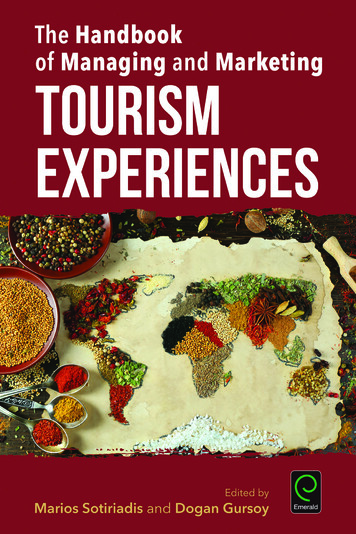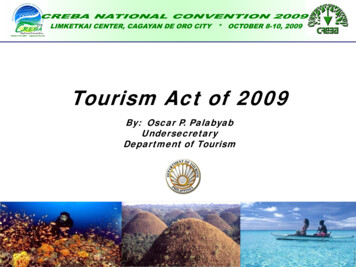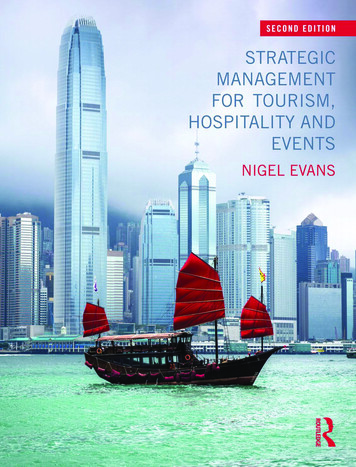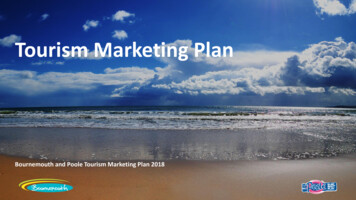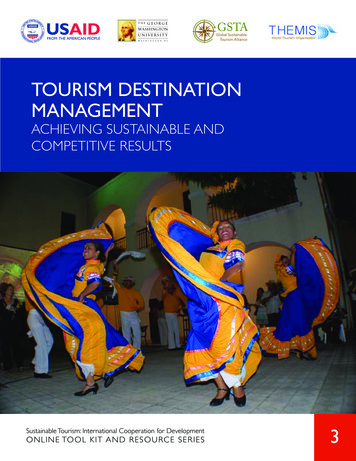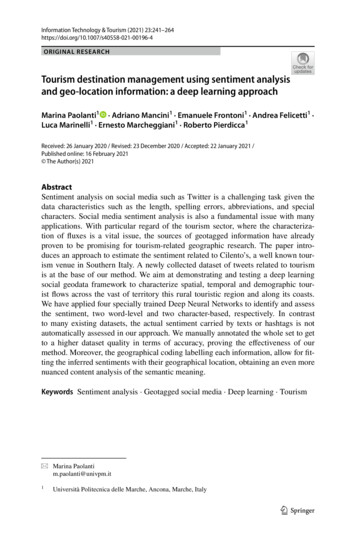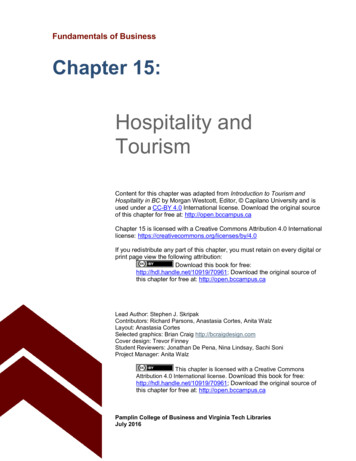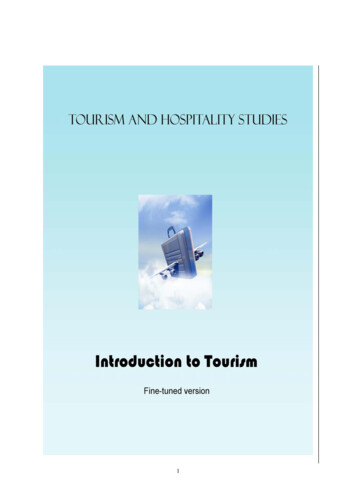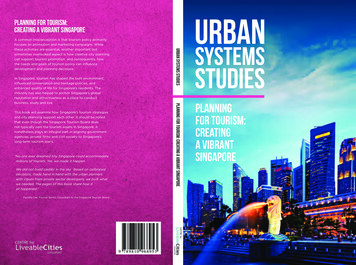
Transcription
Planning for Tourism:Creating a Vibrant SingaporeURBAN SYSTEMS STUDIESA common misconception is that tourism policy primarilyfocuses on promotion and marketing campaigns. Whilethese activities are essential, another important butsometimes overlooked aspect is how creative city planningcan support tourism promotion, and consequently, howthe needs and goals of tourism policy can influencedevelopment and planning decisions.Planning for Tourism: Creating a Vibrant SingaporeIn Singapore, tourism has shaped the built environment,influenced conservation and heritage policies, andenhanced quality of life for Singapore’s residents. Theindustry has also helped to anchor Singapore’s globalreputation and attractiveness as a place to conductbusiness, study and live.This book will examine how Singapore’s tourism strategiesand city planning support each other. It should be notedthat even though the Singapore Tourism Board doesnot typically own the tourism assets in Singapore, itnonetheless plays an integral part in aligning governmentagencies, private firms and civil society to Singapore’slong-term tourism plans.“ No one ever dreamed tiny Singapore could accommodatemillions of tourists. Yet, we made it happen. We did not build castles in the sky. Based on calibrateddecisions, made hand in hand with the urban plannerswith inputs from private sector developers, we built whatwe needed. The pages of this book share how itall happened.”Pamelia Lee, Former Senior Consultant to the Singapore Tourism Board9 789810 968953Planningfor Tourism:Creatinga VibrantSingapore
Planning forTourism:Creating a VibrantSingapore
Urban Systems Studies (USS) BooksFinancing a City: Developing Foundations for Sustainable GrowthLand Acquisition and Resettlement: Securing Resources for DevelopmentBuilt by Singapore: From Slums to a Sustainable Living EnvironmentCleaning a Nation: Cultivating a Healthy Living EnvironmentFor product information, visit apore Urban Systems Studies Booklet SeriesWater: From Scarce Resource to National AssetTransport: Overcoming Constraints, Sustaining MobilityIndustrial Infrastructure: Growing in Tandem with the EconomySustainable Environment: Balancing Growth with the EnvironmentHousing: Turning Squatters into StakeholdersBiodiversity: Nature Conservation in the Greening of SingaporeFor product information, visit able and Sustainable Cities: A FrameworkFor product information,visit .htmPlanning for Tourism:Creating a VibrantSingaporeFirst Edition, Singapore, 2015
Editorial TeamChief Editor:Khoo Teng Chye, Executive Director, Centre for Liveable CitiesProject Leader:Hee Limin, Director, Centre for Liveable CitiesAssistant Project Leader:Nicole Chew, Manager, Centre for Liveable CitiesResearch Advisor:Lim Neo Chian, Fellow, Centre for Liveable CitiesResearch Supervisor:Adeline Lim, Deputy Director, Centre for Liveable CitiesEditor:Researcher:CONTENTSList of IllustrationsviiList of AppendicesixWu Wei Neng, Senior Assistant Director, Centre for Liveable CitiesForewordxiCheong Kay Teck, Manager, Centre for Liveable CitiesPrefacexiii 2015 Centre for Liveable Cities (CLC), Singapore. All rights reserved.CLC is a division ofAcknowledgementsxvThe CLC Liveability FrameworkxviOverviewContext of the Tourism Industry Then and Now1Colonial Legacy as a Free Port of Call3Set up in 2008 by the Ministry of National Development and the Ministry of the Environmentand Water Resources, the Centre for Liveable Cities (CLC) has as its mission “to distil, createand share knowledge on liveable and sustainable cities”. CLC’s work spans three main areas—Research, Capability Development and Knowledge Platforms. Through these activities, CLChopes to provide urban leaders and practitioners with the knowledge and support needed tomake our cities better. www.clc.gov.sgChapter 1Research Advisors for the Centre for Liveable Cities’ Urban Systems Studies are experts whohave generously provided their guidance and advice. However, they are not responsible for anyremaining errors or omissions, which remain the responsibility of the author(s) and CLC. A Watering Hole for the People:Singapore Zoological GardensFor publication information, please contactNicole Chew 65 66459628Centre for Liveable Cities45 Maxwell Road #07-01The URA CentreSingapore 069118Nicole Chew@mnd.gov.sgISBN 978-981-09-6895-3 (print)ISBN 978-981-09-6896-0 (e-version)All rights reserved. No part of this publication may be reproduced, distributed, or transmitted in any form or byany means, including photocopying, recording, or other electronic or mechanical methods, without the priorwritten permission of the publisher.Every effort has been made to trace all sources and copyright holders of news articles, figures and information inthis book before publication. If any have been inadvertently overlooked, CLC will ensure that full credit is givenat the earliest opportunity.Cover photo:The Merlion at the mouth of the Singapore River, with the Fullerton Hotel and the Central Business District in thebackground. Photo courtesy of Redbean De Pte Ltd.Early Tourism Capability Development (1960s–1970s)9 Formation of the Singapore Tourist Promotion Board11 Making the Most of the British Legacy16 Tourism Development: An Economic Responseto the British Withdrawal18 Transport Infrastructure to SupportTourism Promotion: Changi Airport22 Tourism Promotion Infrastructure: Hotels,Urban Renewal & Private Sector Investments25 Developing the Local Souvenir Industry:The Merlion and the Singapore Handicraft Centre28 Growing the Business Aspect of Tourism:Singapore Convention Bureau (SCB)31 Laying the Foundation for Tourism Development32Chapter 2 Expanding and Enhancing Tourism Infrastructure(1980s–1990s) 35 Recovering from the Tourism Slump of the 1980s40A Singaporean Theme Park: Haw Par VillaInspiring Local Conservation: Tanjong Pagar Tourism Product Development Plan:The First Tourism Master Plan48 Tourism as a Catalyst for Heritage Conservation49 Conservation and Revitalisation of Historical Areas Ebb and Flow of an Economic Artery: The Singapore River51
Heritage Development and Lighting up the City56 Perfecting the Jewel57LIST OF ILLUSTRATIONS Lighting Up the City: Orchard Road and the Civic District Tourism 21 Master Plan62 A Software Blueprint: The Chinatown ExperienceGuide Plan (EGP)Chapter 3Seeking Distinction as a City (From the 1990s)67 Becoming a Global City69 Growing Economic Volatility and the Revitalisationof the Tourism IndustryEvolution of a Leisure Island: Sentosa89The Long Road to the Singapore Formula One Race Lessons and Future DirectionsEndnotesBibliographyAppendix A Governance Tools for Tourism Infrastructureand DevelopmentAppendix B Singapore Nation Branding38 Exhibit 3: Significant Tourism Developments and Total VisitorArrivals from 2000–201272Photos Singapore was covered in swamp lands in the 50s andearly 60s2 S. Rajaratnam, Paul G. Peralta, Bhagwan Melwani andRun Run Shaw met to discuss the formation of SingaporeTourist Association5 Singapore cityscape6 Dr Goh Keng Swee at the opening of theTourist Promotion Board Office11 Dr Goh Keng Swee at the opening of the Jurong BirdPark in 197118 The Singapore Zoological Gardens21 Changi Airport in 198622 The original Merlion, built in 197229 The Raffles Landing Site in 199033 The annual Thaipusam festival37 An aerial perspective of Chinatown-Kreta Ayer42 Pagoda Street today43 Haw Par Villa in the 1970s45 Shophouses along Neil Road in the Tanjong Pagar area47 The Sultan Mosque in Kampong Glam51 Marina Barrage54 The annual Christmas light-up along Orchard Road58 The General Post Office at Fullerton Square62 The Fullerton Hotel63 The revamped Chinatown Street Market65 Gardens by the Bay74 The Sentosa Causeway86 The Singapore F1 Night Race in 201389 Race cars at the 1966 Singapore Grand Prix9111512312512Exhibit 2: Significant Tourism Developments and Total VisitorArrivals from 1980–200094103pagexvi 81 A MICE Hub and Resort in the City Centre:Marina Bay Sands The Formula One Singapore Grand PrixExhibits Exhibit 1: Significant Tourism Developments and Total VisitorArrivals from 1964–198071Rejuvenation of a Shopping Corridor: Orchard Road The Integrated ResortsDiagrams The CLC Liveability Framework
LIST OF APPENDICESAppendix A overnance Tools for Tourism InfrastructureGand Development123Appendix B Singapore Nation Branding125
FOREWORDIn the early 1960s, Singapore was ill-prepared to tap the tourism sectorfor economic growth. We had few tourism offerings and both ourtourism infrastructure and industry were under-developed. With growingprospects arising from introduction of mass commercial aviation andgrowing curiosity in an exotic region, the Singapore Tourist PromotionBoard (STPB) was formed in 1964 to realise tourism’s economic promise.Working together with like-minded stakeholders in government andindustry, tourism in Singapore began to take shape with more productsand services to entice the visitor. In 1997, the STPB was renamed theSingapore Tourism Board, to better reflect the larger mandate that hadby then moved beyond marketing and promotions, to encompass otherfunctions such as sectoral planning, development, and regulation.50 years after embarking on its tourism journey, Singapore is a leadingtourist destination with a clutch of global accolades to its name. Whatit offers the visitor today—vibrancy and diversity in food, culture,shopping, events and entertainment—makes for not just a top leisuredestination, but a leading international business events city.It has certainly been an exhilarating 50 years for Singapore tourism,with many high points and not without its fair share of tribulations. It istherefore timely to conduct a retrospective, and offer a deeper and moreinsightful study of its development over the years. It is also a story worthtelling and sharing.Planning for Tourism: Creating a Vibrant Singapore is a study into thesefive eventful but fulfilling decades. Starting with an elaboration of thetourism landscape in the 1960s, it provides a comprehensive accountof the challenges faced by a struggling nation. It takes readers throughland use planning, development of tourism infrastructure, expandingand enhancing tourist attractions, up till the recent transformation ofSingapore into a vibrant global city. It recounts challenges faced at eachphase of growth and how key policies and decisions for sound urbanand development planning have helped to provide a much needed boostto tourism development.
We hope you will find this account of Singapore’s tourism journeyboth informative and inspiring. Thanks to the visionary leadership andstrategic pragmatism of Singapore’s tourism pioneers, the foundationwas set for us to arrive at where we are today.But the journey continues. We invite you to join us as we move towardsa Singapore that is not just a compelling destination for tourists, but alsoone that Singaporeans can proudly call home.I would also like to thank the Centre for Liveable Cities team working onthis as they have accomplished something quite special. Thank you.Lionel YeoChief Executive OfficerSingapore Tourism BoardPREFACEThe Centre for Liveable Cities’ (CLC) research in urban systems tries tounpack the systematic components that make up the city of Singapore,capturing knowledge not only within each of these systems, but alsothe threads that link these systems and how they make sense as awhole. The studies are scoped to venture deep into the key domainareas the CLC has identified under the CLC Liveability Framework,in attempting to answer two key questions: how Singapore hastransformed itself to a highly liveable city within the last four to fivedecades, and how Singapore can build on our urban developmentexperience to create knowledge and urban solutions for current andfuture challenges relevant to Singapore and other cities through appliedresearch. Planning for Tourism: Creating a Vibrant Singapore is the latestpublication from the Urban Systems Studies (USS) series.The research process involves close and rigorous engagement ofthe CLC with our stakeholder agencies, and oral history interviewswith Singapore’s urban pioneers and leaders to gain insights intodevelopment processes and distil tacit knowledge that has beengleaned from planning and implementation, as well as governance ofSingapore. As a body of knowledge, the Urban Systems Studies, whichcover aspects such as water, transport, housing, industrial infrastructureand sustainable environment, reveal not only the visible outcomes ofSingapore’s development, but the complex support structures of oururban achievements.CLC would like to thank the Singapore Tourism Board and all thosewho have contributed their knowledge, expertise and time to make thispublication possible. I wish you an enjoyable read.Khoo Teng ChyeExecutive DirectorCentre for Liveable Cities
ACKNOWLEDGEMENTSThe Centre for Liveable Cities (CLC) gratefully acknowledges theSingapore Tourism Board for assistance provided in the preparationof this book.The CLC would like to extend special thanks to Pamelia Lee and LimNeo Chian, for their guidance and continuous support. The Centre isalso grateful for the assistance and advice from the following urbanpioneers (in alphabetical order): Jennie Chua, Foo Chek Chia, Goh HupChor, Bernard Harrison, Edward Koh, Michael Koh, Kwek Mean Luck,Leong Yue Kheong, Jasmine Lew, Loh Lik Peng, Gopinath Menon,Pek Hock Thiam and Tan Chin Nam.Cheong Kay Teck, the researcher, would like to extend special thanksto his CLC colleagues, cluster mates and the late Joanna Yong. Hewould also to thank the following people who provided advice andencouragement throughout (in alphabetical order): Chang Chee Pey,Chiang Hai Yin, Eddie Choo, June Gwee, Peggy Lai, Anna Lim, PaulineLow, Samantha Seah, Edmund Tan, Margaret Teo, Toh Boon Kwan,Wu Wei Neng and Ivan Wong.
THE CLC LIVEABILITYFRAMEWORKThe CLC Framework is derived from Singapore’s urban developmentexperience and is a useful guide for developing sustainable andliveable cities.The general principles under Integrated Master Planning andDevelopment and Dynamic Urban Governance are reflected in thethemes found in Planning for Tourism: Creating a Vibrant Singapore,detailed on the opposite page:Integrated Master Planning and DevelopmentThink Long TermSingapore’s primary objective of tourism has been to create “a good public imageof Singapore in the world”. The idea is not only to provide work and income forresidents, but also to give Singapore a distinctive and favourable identity in themap of the world, to ensure repeat visitors. Tourism was also pursued in line withother aspects of national development and national objectives.(see Formation of the Singapore Tourist Promotion Board, p. 11)Fight ProductivelyMoving Singapore’s airport from Paya Lebar to Changi was a multi-agencyeffort that involved exhuming graves, reclaiming land, resettling residents andlandscaping a major expressway. This process was expedited and completedwithin six years, down from the originally scheduled ten.(see Transport Infrastructure to Support Tourism Promotion: Changi Airport, p. 22)Innovate SystemicallyHighQualityof LifeIn Singapore, tourism is promoted as an economic sector. This not only facilitatestourism development and planning efforts as funds can be readily obtained on thebasis of future investment returns, but also enables other economic and industrialdevelopment agencies to support such efforts.(see Formation of the Singapore Tourist Promotion Board, p. 11)SustainableEnvironmentCompetitiveEconomyTourism development and conservation policy have been complementary toeach other, to strike a balance between retaining the heritage of a city andmaximising the economic potential of land. From the 1980s, the adaptive use ofconserved buildings was promoted, allowing them to be used in new ways ratherthan insisting on retaining the original occupants and trades which may not besustainable and supportive of other livelihoods in the area.(see Inspiring Local Conservation: Tanjong Pagar, p. 46)Integrated Master Planning and Development Think Long TermFight ProductivelyBuild in Some FlexibilityExecute EffectivelyInnovate SystemicallyDynamic Urban Governance Lead with Vision and PragmatismBuild a Culture of IntegrityCultivate Sound InstitutionsInvolve Community as StakeholdersWork with MarketsDynamic Urban GovernanceLead with Vision and PragmatismTourism promotional efforts to increase visitor arrivals were partly financed by acessation tax levied on first-class hotels, which were considered “the direct andprincipal beneficiaries of any expansion of the tourist trade in Singapore”. The cessationtax was later extended to food and beverage charges for first-class restaurants andfirst-class bars (or public houses), and subsequently broadened to cover all sales,and charges levied and collected by all first-class tourist food establishments.(see Formation of the Singapore Tourist Promotion Board, p. 11)Work with MarketsThe mission of the Tourism Board has evolved from being “first class regulators”to “efficient facilitators” of business activity. Flexible allocation mechanisms, forinstance through the Sale of Sites programme, enable the government to respondto the private sector’s demand for land.(see Lessons and Future Directions, p. 94)
1OVERVIEWCONTEXT OF THE TOURISM INDUSTRYTHEN AND NOWIn 1958, Mr William Tan, Assemblyman for Tiong Bahru, argued againstthe S 300,000 budget allocated for tourism promotion. He claimedthat Singapore had only three attractions to offer visitors: swamps,some fine buildings, and the death houses of Sago Lane.1“ This amount that we are going to spend is most ridiculous, unlesswe are going to develop our place here so that more people cancome to Singapore, because tourism is another invisible exportfrom which Singapore can get more income besides trade.”William Tan, Assemblyman for Tiong Bahru2In the 1960s, Singapore was confronted with a problem commonto many developing countries at the time—a dire lack of urbaninfrastructure. It was a small country with a population of 1.6 million,a per capita income of S 1,310 (US 428 in 1960 dollars), and nonatural resources. Historically, Singapore had been a thriving entrepôteconomy that relied on maritime trade, and as a result had fewdomestic industries and little foreign direct investment. Governmentrevenue was insufficient for the construction of key urban systems suchas public transport, public utilities and public housing.Singapore’s leadership identified tourism as a viable economic industry,and a source of much-needed employment, whilst juggling othernational priorities—building physical infrastructure to house and feed afast-growing population, and developing the manufacturing industriesthat paved the way for economic development. Against all odds,Singapore managed, systematically, to set up extensive and effectiveurban infrastructure while taking care of its culture and heritage, whichis, essentially, part of developing a city well.“ Tourism will make Singapore attractive because we want to makethe experience of the visitors memorable effectively increasingthe choices for Singaporeans, enhancing the quality of life forSingaporeans, making the city a lot more liveable.”Tan Chin Nam, Former STB Chief Executive Officer3
2Planning for Tourism: Creating a Vibrant SingaporeCOLONIAL LEGACY AS A FREE PORT OF CALLSingapore was covered in swamp lands in the 50s and early 60s, making itdifficult to imagine the place as a tourist destination.Image courtesy of National Archives of Singapore.There is a common misconception that tourism policy is primarilyfocused on promotion and marketing campaigns. While these areundoubtedly essential, another important but sometimes overlookedaspect is how sound and creative city planning can facilitate andsupport tourism promotion, and consequently, how the needs and goalsof tourism policy influence development and planning decisions.More so than many other economic sectors in Singapore such asfinancial services or electronics, tourism has visibly shaped the builtenvironment, influenced conservation and heritage policies, and offeredleisure and entertainment options that also enhance the quality of lifefor Singapore’s resident population. A successful tourism industry hasalso helped to enhance Singapore’s global reputation and attractivenessas a place to conduct business, study and live.This book will examine how Singapore’s tourism strategies haveinfluenced planning decisions, and how city planning has, in turn,facilitated tourism promotion. This is particularly noteworthy since theSingapore Tourism Board (STB) is usually not the owner of tourismassets such as heritage districts and monuments, but is nonethelessdeeply involved in the early alignment of government agencies, privatefirms and civil society in its long-term tourism plans.While circumstances differ greatly between countries, some usefullessons stand out. Developing venues simply for the sake of touristsmay not always work well, nor be sustainable. Conversely, clear,transparent objectives and sound planning can galvanise stakeholdersand inspire confidence in long-term investments, resulting ineconomically viable tourism attractions that are sensitive to culturalheritage. More often than not, these cases also illustrate howcooperation between various government agencies with different areasof expertise creates better planning and public outcomes.Something should be done bygovernment to bring home totourists and holiday seekers ofthe world the great attractionsof Malaya.Straits Settlement Legislative Council (1930s)4Before attaining self-government in 1959, the potential of tourism asan economic industry for Singapore was voiced as early as the 1930s inthe Straits Settlement Legislative Council. However, the British colonialauthorities did not view tourism promotion as a priority, given theeffort and cost involved.The continued lack of progress on tourism development in the 1950swas largely due to disagreement over whether the government orthe commercial sector should foot the bill for tourism promotion.Private firms strongly resisted any levy or subscription fee to raisefunds for a tourism bureau, arguing that many of them were notreceiving substantial income from tourists yet. On the other hand,the government maintained that a cost-sharing arrangement wasreasonable as companies in Singapore would reap future benefits fromtourism promotion.A working party with representatives from the private sector wasset up in 1955 to examine the pros and cons of a centralised tourismboard. Unsurprisingly, it recommended that the government allocateS 400,000 to S 500,000 annually to fund a centralised tourismboard, and that the private sector’s contribution be limited to theprovision of advice and some commercial advertising.5 However, thegovernment insisted that the tourism board should be a “joint effort”with commercial interests, where the commercial interests played the“major role.”6 This was not well received by the business community.The government subsequently offered to pay 50% of the bureau’s cost,but this was likewise rejected.3
4Planning for Tourism: Creating a Vibrant SingaporeThe following year, the government invited a tourism expert fromNew Zealand, Mr R. W. Fenton, under the Colombo Plan. His taskwas to advise on the prospects for the tourism industry and tourismpromotion measures.7 In his report, Mr Fenton emphasised therevenue potential of the tourist industry, and recommended that thegovernment fund a tourist promotion body with contributions fromthose commercial interests that stood to profit.8While these developments were taking place, Singapore joined theNational Union of Travel Organisations, a subsidiary body of the UnitedNations, and the Pacific Area Travel Association (PATA) in 19559 toraise its international profile and promote the local tourist industry.10With a last-minute bid through cable by Chief Minister Lim Yew Hock in1957, Singapore successfully became the host of the annual conferenceof the Pacific Area Travel Association in 1959.11 Winning the bid gaveadditional impetus for Singapore to establish a national tourism boardprior to the conference.12 With the private sector still reluctant tocontribute, the government decided to provide the required S 30,000in annual financing, and set forth to appoint a Director of Tourismassisted by an advisory committee.13 At the inaugural meeting of theTourist Advisory Board, then Minister for Commerce and Industry,Mr J. M. Jumabhoy commented that it was “the first time in the historyof Singapore that a concerted and organised effort has been made topromote tourism and to attract tourists to the Colony.”14Following that, a suggestion to form a tourist association came fromMr E. J. C. Gardner, manager of the travel department of Mansfield& Co., Ltd., in a letter to the Singapore Chamber of Commerce on 4December 1959, which the Chamber supported. A group of prominentbusinessmen, bankers, traders, travel agents, shipping and airlineexecutives attended a meeting at the Ministry of Culture in City Hall on6 January 1960, chaired by Mr S. Rajaratnam, then Minister for Culture.The decision was made to form a tourist association, with the Ministeras honorary president.19The event marked the first time a private, non-profit makingorganisation undertook the important task of promoting, developingand facilitating travel to Singapore with the support and cooperation ofthe government. This was to be the state of affairs until the SingaporeTourist Promotion Board was formed in 1964.The post of Director of Tourism was later assigned to Mr RobertHowlett from Fiji, the past General-Secretary of Fiji Visitors’ Bureau.15He recommended various survey methods and tourist promotionmeans, highlighting the need for Singapore to coordinate “its touristfacilities and its available tourist attractions in a manner in which thewhole picture can be presented to the potential visitor.”16 Unfortunately,not long after the successful 1959 PATA conference which helpedestablish early regional networks to cooperate in bringing moreattention to the Pacific area,17 the Tourism department was closed tosave money, and its work—mainly to do with publicity—was subsumedunder the Ministry for Culture.18S. Rajaratnam , then Minister for Culture, (second from left) met with (left toright) Paul G. Peralta, Bhagwan Melwani and Run Run Shaw to discuss theformation of Singapore Tourist Association.Image from Paul G. Peralta Collection, courtesy of National Archives Singapore.5
Singapore cityscape.Image courtesy of Thomas Timlen.
Planning for Tourism: Creating a Vibrant SingaporeCHAPTER 1Early TourismCapabilityDevelopment(1960s–1970s)
Planning for Tourism: Creating a Vibrant SingaporeChapter 1We can broaden our serviceand export base in several ways.The first and most obvious istourism, and that is providingservices to tourists from Europeand America who want to seethe Orient.Dr Goh Keng Swee, Minister for Finance, 16 April 196720Although tourism was identified as a potential economic growth area,there were significant challenges since Singapore had few historicallandmarks, and no outstanding natural scenery or even good beaches.21To tourists at that time, Singapore was more a transit stop than adestination in its own right.2210FORMATION OF THE SINGAPORE TOURISTPROMOTION BOARDThe Singapore Tourist Promotion Board (STPB) was formed on 1January 1964. Then Minister for Finance Dr Goh Keng Swee announcedthat it was “the first time in Singapore’s history that the [independent]government has decided to accept as a conscious policy the promotionof an increasing inflow of tourists into the State. Until now, the matterhas been left almost entirely in the hands of private enterprise”.23 TheBoard was a timely platform for the government and private enterpriseto cooperate to increase visitor arrivals, in view of the “phenomenalexpansion” of the international tourist trade after World War II.24Back in 1963, then Minister for Culture, Mr S. Rajaratnam, had alreadyemphasised that Singapore should regard tourism “more as an industrythan an exercise in publicity promotion”.25 In line with this approach,Dr Goh tasked STPB with two objectives: first, to “get as many touristsas possible from abroad to visit”; and second, to “ensure that thesetourists get good value for their money” and leave Singapore satisfied,so that “the word gets around”, encouraging more visitors.26Starting from an almost clean slate, Singapore took decisive stepsto develop tourism as an economic sector. The government set upa national tourism organisation to develop tourism policies andstrategies, and coordinate these with other national priorities. It madethe most of Singapore’s British colonial heritage, worked with theprivate sector to provide the infrastructure required to support thefledgling industry, and developed facilities to attract business andconference travellers.Dr Goh Keng Swee, then Minister for Culture, at the opening of the TouristPromotion Board Office at the John Little Building in Raffles Place, in 1964.Image from Ministry of Information and the Arts Collection, courtesy of National Archives of Singapore.11
EXHIBIT 1Significant Tourism Developmentsand Total Visitor Arrivals from1964–1980Below 500,000500,001 – 1,000,0001,000,001 – 1,500,0001,500,001 – 2,000,0002,000,001 – 2,500,000*Excludes Malaysian Citizens arriving by land SG HandicraftCentre Opens Changi AirportDecision Sentosa Bird Park &Zoo Decision SG ConventionBureau Formed1,492,2181,681,985 Special Committeefor Conservation ofTourist Attractions Instant AsiaCultural Show1,324,3121,233,854 E ra of CommercialJet Transportatio
by then moved beyond marketing and promotions, to encompass other functions such as sectoral planning, development, and regulation. 50 years after embarking on its tourism journey, Singapore is a leading tourist destination with a clutch of global accolades to its name. What . it offers t
